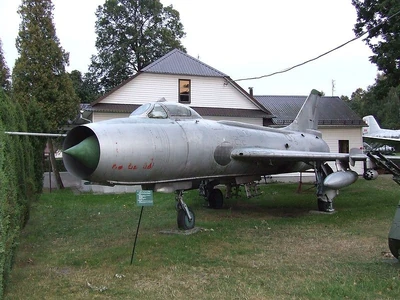The Sukhoi Su-7 (NATO codename: „Fitter“) is a single seat, single engine fighter, designed to be a low-level

dogfighter, but because it was unsuccessful in this role, it was used as a fighter-bomber in the 1960s.
Development[]
Development of the Su-7, which was primarly designed to act as an Interceptor aircraft, begun in 1950. In the year 1955, the first prototype had it´s first flight, it was called S-1 Strelka, and was flown by A. Kotschetkow. During testing a maximum speed of 2170 km/h was reached. On 24th July 1956 it was first shown publicly. The prototype S-2 was built in small numbers and used by the Soviet Military with the name S-22. It was the precursor variant of the Su-7B fighter-bomber. The Su-7B is the result of a interceptor variant that was modified into a fighter-bomber, which became the flag-ship fighter-bomber of the Soviet Air Force. The Su-7 was built from 1958 to 1976 and was often upgraded; it was replaced by the variable-sweep wing fighter-bomber Su-17.
Main variants were the Su-7 BKL a Rough-field capable variant with skids affixed to the sides of the main landing gear and the most built variant, the Su-7 BM, with a more powerful AL-7F-1-engine and with two additional external hardpoints, a more advanced ejection seat and the more advanced “Sirena 3” radarwarnreceiver. The Su-7U and the Su-7UM were trainer variants.
The Su-7 is equipped with two 30 mm NR-30 machine guns with 70 rounds each and it is able to carry bombs, missiles or rocket pods on four external pylons and on two fuselage hardpoints it can carry external fuel tanks with a weight up to 4000 kg.
Today only the North Korean Air Force operates the Su-7.